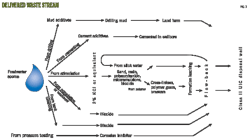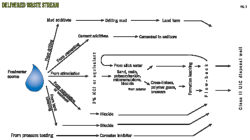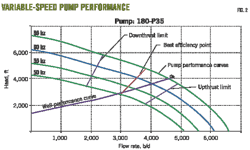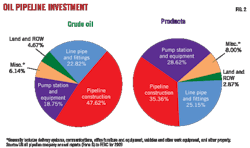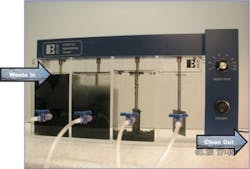Theodore A. Pagano
Consultant
Denver
Tom Evans
ProTreat Technology Corp.
Denver
A novel treatment enables operators to reuse Class II oil and gas waste streams from Greater Wattenberg Oil and Gas field in the Denver-Julesburg basin.
ProTreat Technology Corp. and Conquest Water Services collaborated on developing and implementing the method.
Wattenberg is a tight oil and gas field with wells typically spaced on 20 acres. The field has more than 20,000 wells within a large agricultural area with fast growing population centers.
Operating in the area requires that oil and natural gas companies cooperate and coexist with municipal and state water consumption considerations associated with the region's predominant surface business interests and urban expansion.
Conquest Water Services is the basin's largest handler of oil and gas waste streams and typically disposed of these streams in deep Class II injection wells.
With tightening supply and increasing pressure for water stewardship, Conquest and ProTreat identified a Class II oil and gas waste treatment and recycling method that would enable Wattenberg's operators to reduce their draw on municipal and state water.
The method required new technology and compliance with regulations and possibly will allow for waste-free operations in the basin.
Waste-water streams
Advancements in horizontal drilling and multistage stimulation have allowed the industry to develop several new shale plays throughout the US. Successful exploitation of these plays requires companies to use more water than historically needed for a well's initial completion and to handle additional produced water after the well is on stream.
In some regions, the needed water volume for proper resource development is not readily available or is becoming less available.
As a result, operators have an interest in the reuse of flowback water from a well's initial completion and a well's produced water.
Companies are asking oil and gas engineers who are well versed in natural resource exploitation but poorly versed in water treatment to navigate the realm of water treatment technologies that mostly have been developed and deployed in municipal water treatment settings and do not have an application in oil and gas.
On the other hand, water treatment engineers, versed in water treatment but poorly versed in oil and gas operations, are being asked to treat oil and gas water that has natural and induced constituents that do not have a preestablished technological treatment solution.
In addition, petroleum, service, and water treatment companies often underestimate the difficulty of successfully treating oil and gas waste and consequently make erroneous investments in both time and capital.
Every basin poses unique operational challenges associated with water treatment, reuse, recycling, and volume control. Also each producing formation in a basin may have different waste stream qualities with varying degrees of treatment difficulty.
Furthermore, waste stream qualities may change as the basin or wells mature or as completion and stimulation methods change.
Two principal issues that befuddle water treatment experts and render conventional water treatment methods inapplicable are:
1. The waste stream constituents are unique to oil and gas and the most prevalent constituents will foul or overwhelm conventional water treatment technologies.
2. Oil and gas waste streams have a high variability that cannot be controlled.
The worldwide volume of produced water generated by the oil and gas industry is about 77 billion bbl/year,1 and there are few examples of successful oil and gas waste treatments in which the waste stream had high constituent variability.
The most successful water treatments ashore have been on produced water from coalbed methane projects, steamfloods, and waterfloods. In each, the water contains either low oil and gas constituents, such as produced from dewatering coal beds, or the waste stream variability is nominal, as in steamfloods, waterfloods, and coalbed water. Treatments also have been successful where constituents from stimulation (whether slick water, polymer, or acid-based) or completion chemicals are absent.
Wattenberg waste stream
Conquest operates commercial Class II oil and gas waste facilities. This means that Conquest must accept waste streams from all petroleum operators and their service providers, each having different operating practices and fluid additives.
The delivered waste stream (Fig. 1) to Conquest is a mixed and uncontrolled combination of:
• Produced water from seven different producing horizons, most of which is delivered black and sour, highly contaminated with anaerobic and aerobic bacteria, and with high iron sulfide content.
• Flow-back water from slick water stimulation.
• Flow-back water from polymer-based stimulations, including low pH and high pH systems.
• Flow-back water from acid stimulation.
• Waste water from workover operations.
• Tank bottoms.
• Other waste streams from supporting operations, such as pressure testing and tank cleaning.
Conquest's waste feed stream contains a large amount of difficult-to-treat oil and gas constituents and varies not only from day to day, but from hour to hour, and from truck load to truck load. For a 7-day period, the average waste intake at a single Conquest site is about 60% flow-back and 40% produced water.
Companies have developed Wattenberg field on low cost, repeatable reserve growth approach that has lowered capital and lease operating expenses. Furthermore, the field is in a highly populated area with established air permitting requirements that limit use of open-digestion pits.
To provide a cost effective, instant and pitless, commercial Class II waste water treatment required Conquest and ProTreat to improve treatment methods and operational procedures that could handle difficult-to-treat oil and gas constituents and unpredictable waste stream variability in a basin highly sensitive to cost consideration.
Fig. 2 is a simplified breakdown of the constituents encountered in oil and gas waste streams, sorted by increasing treatment complexity.
Existing water treatment methods used in industrial and municipal settings are applicable sometimes for some of these constituents, but none of these methods can always handle all of them. Furthermore, the volume at which those constituents are introduced to a waste stream changes dramatically during oil and gas operations.
Harsh conditions and slugs of particular constituents lead to eventual mechanical fouling or immediate mechanical fouling. Eventual fouling is as common as immediate fouling; therefore, critical attention must be applied to the projected life span of a particular water treatment method. What may appear to be an immediate bench test success, may ultimately fail in real oil and gas operations.
In general, produced water treats easier than flow-back water. Flow-back water contains added constituents for improving well performance and reserve life that are difficult to treat. Completion additives are other substances that can cause traditional water treatment methods to be ineffective.
The following list indicates some of the problems traditional treatment methods have with the waste streams such as the Conquest-ProTreat waste stream.
• Activated carbon filtration could not treat the large volume of friction reducers and surfactants in the water.
• Due to similar additives, coallescors and dissolved air flotation were ineffective because of the additives used for reducing fluid-fluid and fluid-solid interfacial tension.
• Electric coagulation could not handle the amount of intentionally emulsified oil, stimulation constituents, and sustained volume of high organics for an extended period.
• Traditional softening was not possible because of pH variations introduced to the system that range from 4 to 10.5 due to different stimulation designs and the intentional introduction of sequestering agents.
• Traditional seeding and coagulation techniques could not handle light acids associated with completion fluids, unbroken polyacrylamides and gels, and corrosion inhibitors.
• Stand-alone oxidizers were ineffective because of high volumes of organics, emulsions, and iron sulfide.
• Mechanical means of water treatment introduced risks of mechanical fouling and process failure. By their nature, mechanical means are capital intensive, and scaling up in size to treat a larger volume of water means increased capital exposure. Furthermore, there is not a single method of mechanical treatment. Each technology needs a complementary precursor, whereby any upset to one, may upset all. In Conquest and ProTreat's application, diverting produced water from flow-back water was not an option (Fig. 3). This significantly raised the risk of mechanical fouling, whether immediate or eventual.
Technical solution
To avoid the risk of mechanical fouling, its associated capital intensity, and likelihood of failure, Conquest and ProTreat took a different approach. Based on their knowledge of oil and gas operations, previous oil and gas water treatment attempts, oil and gas completion chemistry, and water treatment chemistry, the companies developed a means for instantaneous treatment of Class II oil field waste streams with chemical processes.
Also, after a review of the basin's waste stream and water needs for continued resource development and field maintenance, the companies intentionally avoided full desalination.
Water reuse
Fig. 4 compares retained permeability for various salts as determined through laboratory analysis.2 Controlling clay swelling and pore throat plugging is a necessary consideration for any completion and workover operation because it has the potential to affect well performance. This consideration becomes more important in shale reservoirs where clay content is high and completion volumes are large.
The prevalent salt used by the industry is KCl because of its lower critical salt concentration, ease of dissolution into fresh water and brine at ambient temperature, and proven effectiveness.
Fig. 4 shows that NaCl is excellent at controlling clay control, especially in the event one can avoid abrupt changes in salinity between the fluid naturally present in the formation and any injected fluid.
Use of NaCl for clay control has logistical problems. NaCl also does not handle well, does not go into solution well, and requires larger volumes for adequate clay protection than its alternatives. These problems are circumvented in the event the formation produces NaCl, whether naturally or via flow-back due to formation leaching.
The use of lease brine for completions and workovers is not new to the industry. Without proper treatment, however, lease brine or brine created via formation leaching, will cause damage, both to the formation and wellbore as a result of bacteria, sulfur, iron, clay particulates, hydrocarbons, dissolved oxygen, hardness, and man-made constituents especially in shale and silty-shale reservoirs where effective pore throats typically are less than 1 µm.
By avoiding desalination, while simultaneously removing harmful constituents, the companies avoided the increased capital expense, operating costs, and risk of mechanical fouling associated with distillation and membrane filtration. At the same time, the effluent stream produced from the treatment is a long standing oil field product—a KCl-NaCl brine mix that operators can deploy not only in stimulation and completion practices but throughout the basin for operational support and production maintenance.
In Wattenberg, treated water is delivered at a discount to makeup brine. This enables operators an opportunity to recycle water, while at the same time, reduce lease operating expenses.
The bench test shows the removal of the difficult-to-treat oil and gas constituents from the waste stream (Fig. 5).
Fig. 5 is a photo of a bench test showing the feed stream in and the treated stream out. The treatment effectively removes the oil and gas constituents listed in Fig. 2. These include residual surfactants, polyacrylimides, microemulsions, gels, sequestering agents, breakers, catalysts, and other industrial induced completion substances.
The process also removes sugars or starches, which can promote bacterial growth once exposed to contaminated oil field equipment, and virtually eliminates scaling tendencies.
The table lists additional generalized parameters of concern in oil field water treatment and reuse. Typical inlet turbidity measures between 1,500 to 2,500 National turbidity units. Quality control parameters currently target less than 5 NTUs for delivered brine; however, water is often delivered at 0.5 NTUs. This level of clarity exceeds typical oil field water clarity, whether well water, fresh water, or makeup brine.
In the event that oil and gas waste streams are to be adequately treated for oil and gas reuse as it pertains to stimulation, consideration must also be taken to address polymer and slickwater chemistry and its sensitivity to recycled water.
Chemical additive effects on the upstream treatment side can inhibit reslick or recross-link capabilities. A water's hardness, pH, number of cations and anions, and miscellaneous other constituents, if improperly balanced, can result in under or over cross-linking, delayed cross-linking, poor viscosity, and changing breaker schedules, any of which threaten stimulation performance. Furthermore, stimulation chemicals vary by provider and change without notice; so that treatments must be strong and flexible enough to handle unforeseen and immediate changes.
Treatment facility
Fig. 6d shows the treatment site next to a commercial Conquest Class II deep well disposal site in contrast to treatment methods that require pits (Figs. 6a-c), which are not an option for a commercial facility in Colorado.
The treatment site is next to Conquest's Class II deep well disposal facility (D). Other treatment methods require pits (A-C; Fig. 6).
The facility has the capacity to treat 150-200 gpm, or about 5,000-6,500 b/d. Based on necessity and daily demand, intake waste streams can be sent to deep well disposal or back to industry for reuse. Combined, this treatment method lengthens the life of the disposal well by substantially reducing the volume injected downhole. In the alternative, the same facility can handle twice the volume because reuse has become an alternate means of water handling.
Apparent from the picture, capital requirements are minimal, requiring tanks, and mixers for six distinct and unique chemical processes that result in a rapid, highly effective treatment. The result is a coagulation and flocculation process that results in a waste stream that is less than 1% of the inlet stream.
The applied coagulation and polymer chemistry is so effective that clarification is accomplished with a vertical tank. Treatment time is slightly more than 2 hr. The produced waste stream has about 80% water content, enabling effective drying through a filter box without additional treatment with a filter press or sludge dryer, either of which would require additional maintenance, investment, and operating cost.
The process produces a dried filter cake that supports plant growth or can be hauled to a landfill for disposal (Fig. 7).
The dried filter cake (Fig. 7) supports plant growth and is hauled to a land fill for disposal. Up scaling the treatment rate and volume throughput is simpler and less expensive than any alternate mechanical method, requiring only larger tanks and mixers. This makes the treatment process applicable not only to large-scale recycling efforts, but also to large-scale secondary and tertiary recovery projects requiring high water rates (30,000-100,000 bw/d).
Conquest's technical effort was complemented with simultaneous, precedent-setting regulatory and state water rulings. This enabled start-up of Colorado's first commercial oil and gas field water recycling site, applicable to Conquest's network of locations in the Denver-Julesburg basin, and also set the groundwork for other basins with water considerations, enabling prudent, state-wide handling of produced water.
The specific treatment technology being employed (chemistry and process) was developed by ProTreat and is covered under ProTreat's international patent.
The process devised in Wattenberg, driven by necessity and price control, has successfully treated brines from across the US with total dissolved solids ranging from 10,000 to 250,000 mg/l.
There are some basins where produced-water volume exceeds completion and operational needs and full desalination is required for volume control or discharge. In any such event, the Conquest-ProtTreat treatment method may serve as a means of pretreatment for further desalination efforts.
In most cases, as demonstrated in Wattenberg, there is a place for industry specific reuse, and the method described in this article provides an alternative to traditional disposal and water handling.
Where operators require makeup brine, the method provides a cost competitive, resourceful alternative because the process leaves untouched the brine weight and natural clay control agents.
Acknowledgments
The authors acknowledge Dale Bucher and Bruce White of Conquest Water Services for their help in development of the process and their permission to publish this article.
References
1. Veil, J.A., et al., A White Paper Describing Produced Water from Production of Crude Oil, Natural Gas, and Coal Bed Methane, Argonne National Laboratory, Argonne, Ill. January 2004.
2. Crow, C.W., "Laboratory Study Provides Guidelines For Selecting Clay Stabilizers," Paper No. SPE 21556, CIM/SPE International Technical Meeting, Calgary, June 10-13, 1990.
The authors
More Oil & Gas Journal Current Issue Articles
More Oil & Gas Journal Archives Issue Articles
View Oil and Gas Articles on PennEnergy.com
